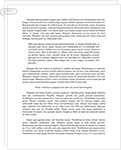 Study Document
Study Document
Healthcare Strategy Other
Health Care
A target market is defined as recognizable segments that make up the market, and the target market consists of the groups the organization wants to focus on (Swayne, Duncan & Ginter, 2008). There are a number of ways that a target market can be understood. The main breakdowns in health care are geography, demographics, payer and specialty (Gandolf, 2010).
Geography is perhaps the simplest one. It reflects the service radius that the hospital wants to serve. In Emanuel's case, does it want to serve mainly Turlock, or does it consider its playing field to be broader. Is it competing for customers in the major towns in the area? In some respects, the other competitors in the market are defining for Emanuel what its geographic target market is, since they are winning customers away from Emanuel.
Demographics reflects the ways of describing the people in your target market. The senior care home that Emanuel runs has a target market of seniors, Cypress, which is different from Emanuel's hospital. The change in target market brought about by EMTALA has changed Emanuel's business somewhat, and perhaps the company has not made adjustments to the way it does business to better align with its new target market. If Emanuel is seeking to focus on Turlock and surrounds, it will not have a demographic target because the potential market is too small. But if it wants to specialize and target people from the larger towns, then it should have a demographic target market in mind.
Payer is another way of understanding the target market for health care. In most businesses, the payer is the user, but in health care the payer is often not the end user. There are a number of different payers -- private individuals, insurance companies and various government programs. Emanuel can choose to cut any payer on which it consistently loses money Or, if it realizes that a particular payer is the most common, maybe it tailors its service offering to that payer. For example, Emanuel may have mainly government payers. It might complain about not having money to invest in new equipment, but a predominantly government-pay model means high volumes and low margins, including less frequent investments in equipment.
Lastly, there is specialty. Many health facilities develop specialties, either because they have competency or because they feel there is a market need. If there is something that is underserved in the Emanuel catchment area, then the company can look to specialize in those types of patients. Like an area with a lot of seniors might specialize in gerontology or in ailments that target seniors, for example.
So there are a number of different ways for Emanuel to better understand its target market. Should the company so desire it will be able to utilize target marketing to streamline its operations, market to specific markets, and hopefully just better align its business philosophy and service approach with the needs of its chosen target market, or markets.
Student #2. There are a few approaches that Emanuel can take to define its market. The company right now seems to have relied on its geographic positioning, being in a small town, but as it seen a lot that is not enough. People are more than willing to drive farther to save some money or to get better service. Thus, it is important for any health care provider to start thinking like a marketer and really get a better sense on who it is that they serve.
Now, among the ways to break down and define the market is by age, income, job status,…
Sample Source(s) Used
References
Dranove, D. & Satterwaite, M. (2000). The industrial organization of health care markets. Handbook of Health Economics. Vol. 1 (B) 1093-1139.
Gandolf, S. (2010).
How to define your target audience -- a critical health care marketing success factor. Health Care Success Strategies. Retrieved November 24, 2014 from http://www.healthcaresuccess.com/blog/branding/define-target-audience.html
McQueen, M. (2007). Health insurers target the individual market. Wall Street Journal. Retrieved November 24, 2014 from http://online.wsj.com/articles/SB118765356072903507
Related Documents
 Study Document
Study Document
Healthcare Strategy
Healthcare Challenges Technology is one of the main drivers of change in healthcare, and it is up to healthcare organizations to join the rest of the world in adopting new technologies to run their industry better. In most industries, something like electronic record keeping has been done for decades and nobody was wringing their hands about it. It is absurd that this is even an issue for healthcare companies. The best
 Study Document
Study Document
Healthcare Strategy
Strategy Health Care First student: There are many barriers to the implementation of strategy in health care organizations. One barrier is that the organizational structure, including chains of command and communication, may pose barriers. This barrier reflects that strategy needs to be communicated effectively, in order to the implemented effectively (Heide, Gronhaug and Johannessen, 2002). Managers must be aware of this, and ensure that there are channels for communication that will
 Study Document
Study Document
Health Care Strategy
Strategic plan II Environmental Analysis An environmental analysis is an important component, and indeed a prerequisite, to the strategic plan. It stands to reason that you cannot set a course for the future without knowing the route you will take, and you cannot know the route until you have the lay of the land. The environmental analysis is "a process in which you look at the outside factors that can have an
 Study Document
Study Document
Health Care Strategy
components of strategic management. They include internal and external analysis, strategy formulation and strategy implementation (Clayton, 2014). The external analysis allows the company to understand what opportunities and threats exist in the market. The internal analysis allows the company to understand its own capabilities and weaknesses, the latter of which might constrain what options it will be able to pursue. Once these are known the company can then formulate
 Study Document
Study Document
Healthcare in the 21st Century:
One such barrier is the pattern of supply-driven care that has proven extremely costly on the average consumer and patient. Essentially, this method of healthcare has created a multi-billion dollar industry, where patients' needs are put to the side in order for healthcare organizations to make the largest profit margin possible through a system that resembles a production line more so than a hospital facility. Unfortunately, "producers control demand"
 Study Document
Study Document
Health Care Options for Pregnant Women
Healthcare for Pregnant Women Comparison: U.S., Switzerland and Canada A Comparison of Healthcare Options Pregnant Women in United States, Canada and Switzerland The healthcare systems in Western societies do not assume that a woman requires health information; however, collectively, it has become well recognized that good information is necessary to a pregnant woman, and that understanding the stages of pregnancy, labor, and delivery is important to good perinatal care (Crook, 1995). This



